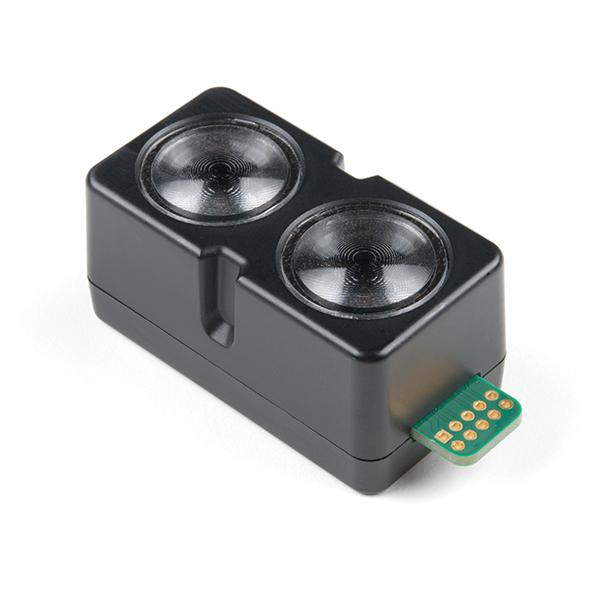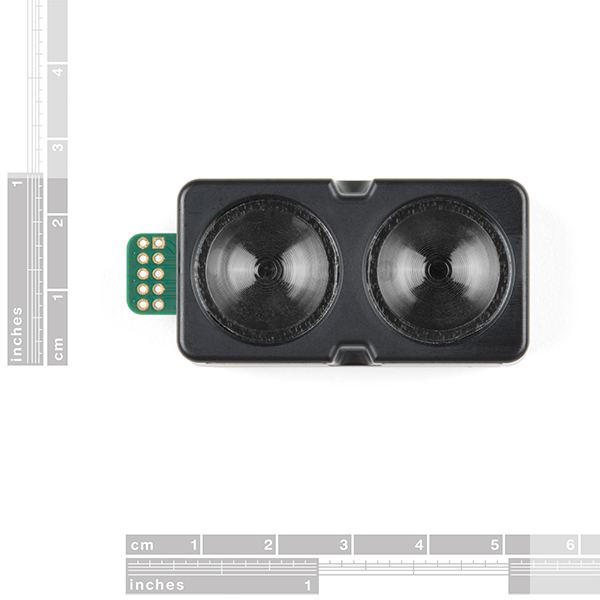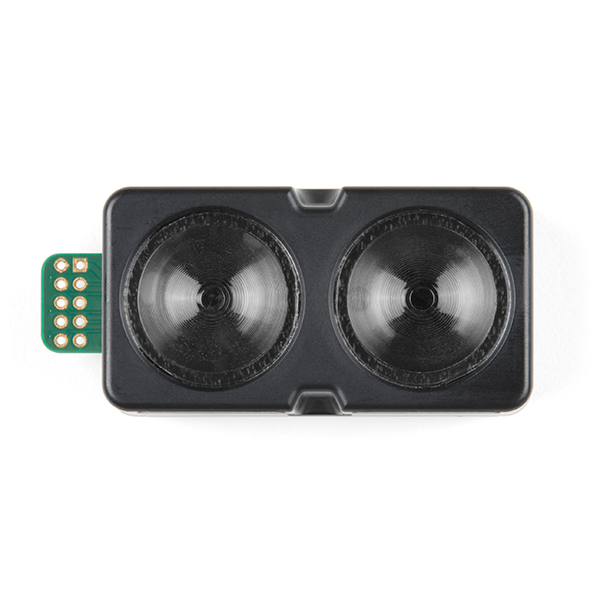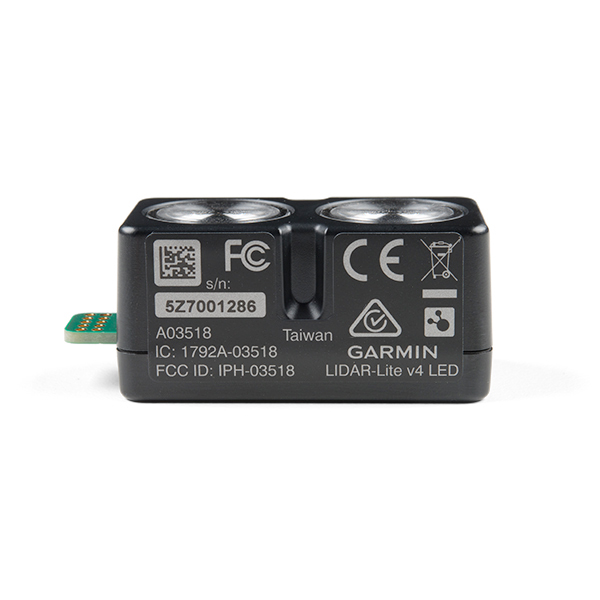The LIDAR-Lite v4 LED sensor is the next step in the LIDAR-Lite line. A small, lightweight, low-power optical ranging sensor. It's the first to incorporate ANT profile wireless networking technology into an optical sensor. Its built-in nRF52840 processor means that developers can create custom applications, or be operated as a stand-alone device right out of the box by using the preloaded stock application.
Like the LIDAR-Lite v3 and LIDAR-Lite v3HP sensors; it can also be directly connected to an external micro-controller running a custom user application. As such, it provides a highly adaptable option for OEM and maker applications in robotics, Internet of Things, and unmanned vehicles — or any application where an ultrasonic sensor might otherwise be used. It’s perfect as the basic building block for applications where wireless capabilities, small size, light weight, low power consumption and high performance are important factors in a short-range, 10-meter, optical distance measuring sensor.
The LIDAR-Lite v4 requires an external 5VDC power source and soldering is required. This Time-of-Flight ranging module uses a LED and optics for ranging. It does not use a laser; therefore, it is inherently eye-safe under normal usage.
- LIDAR-Lite v4 LED Sensor
- Documentation
- Resolution: 1 cm
- Measurement repeatability:
- As measured indoors to a 90% reflective target
- 1 cm is equivalent to 1 standard deviation
- Using “high accuracy” mode, with averaging:
- +/- 1 cm to 2 meters
- +/- 2 cm to 4 meters
- +/- 5 cm to 10 meters
- Range: 5 cm to 10 meters (as measured from back of unit)
- Update rate:
- I2C = >200 Hz typical
- ANT® = up to 200 Hz to a 90% target indoors at 2m in normal operating mode
- Interface: I2C or ANT; user configurable for SPI using the Nordic SDK
- Power (operating voltage): 4.75 – 5.25 VDC
- Current consumption: 2mA idle, 85mA during acquisition
- Operating temperature: -20 to 60° C
- LED wavelength: 940 nm
- Beam divergence: 4.77°
- Optical aperture: 14.9 mm
- Unit size (HxWxD): 2.1" x 0.8" x 0.9" (52.2 x 21.2 x 24.0 mm)*
- Weight: 14.6 g (0.5 oz)
Garmin LIDAR-Lite v4 LED - Distance Measurement Sensor Product Help and Resources
Core Skill: Soldering
This skill defines how difficult the soldering is on a particular product. It might be a couple simple solder joints, or require special reflow tools.
Skill Level: Noob - Some basic soldering is required, but it is limited to a just a few pins, basic through-hole soldering, and couple (if any) polarized components. A basic soldering iron is all you should need.
See all skill levels
Core Skill: Programming
If a board needs code or communicates somehow, you're going to need to know how to program or interface with it. The programming skill is all about communication and code.
Skill Level: Competent - The toolchain for programming is a bit more complex and will examples may not be explicitly provided for you. You will be required to have a fundamental knowledge of programming and be required to provide your own code. You may need to modify existing libraries or code to work with your specific hardware. Sensor and hardware interfaces will be SPI or I2C.
See all skill levels
Core Skill: Electrical Prototyping
If it requires power, you need to know how much, what all the pins do, and how to hook it up. You may need to reference datasheets, schematics, and know the ins and outs of electronics.
Skill Level: Competent - You will be required to reference a datasheet or schematic to know how to use a component. Your knowledge of a datasheet will only require basic features like power requirements, pinouts, or communications type. Also, you may need a power supply that?s greater than 12V or more than 1A worth of current.
See all skill levels
Comments
Looking for answers to technical questions?
We welcome your comments and suggestions below. However, if you are looking for solutions to technical questions please see our Technical Assistance page.
Customer Reviews
No reviews yet.





Anyone know if this can be used to measure the distance to the surface of water to measure height of a river?
Thanks
I am still a idiot with all this stuff. How do we put it into High Accuracy Mode?
I am looking at the Garmin Manual, and it says something about 0xEB and the intial value is 0x14.
I have no idea what that means or where to edit that in an Arduino program.
Also, I have this thing siting still on my desk pointing at a wall 40 cm away (using a tape measure). But I am getting readings of 45 - 46 cm. What gives? I was expecting something a lot more accurate than that.
Sorry, I read the post below before this one... Again, if you are looking for technical assistance. Please use the link in the banner above, to get started with posting a topic in our forums. Our technical support team will do their best to assist you.
That being said, the modes are configured on this line in the v4LED example in the Arduino library.
https://youtu.be/nGWtL_FtSic
Also, this seems to read distances up to 2.5m and then it "starts over". Its weird.
Any ideas?
Hi there, it sounds like you are looking for technical assistance. Please use the link in the banner above, to get started with posting a topic in our forums. Our technical support team will do their best to assist you.
Unfortunately, with the stay at home measures in our area; I can't test one. However, I would double check the mode that the LIDAR Lite is being configured with; you might be outside the range for that setting. Additionally, Garmin also offers support on their product and might have some insight on the accuracy issue.
VIN is 5 V, I/O pins ONLY tolerate 3.3 V, keep in mind for trig/mon and I2C usage. Measurement Time will depend on HIGH_ACCURACY_MODE (xEB register) value. The value is used for how many measurements are accumulated and averaged before reporting. Keep in mind the I2C and ANT interfaces operate at 200Hz, which may be the data bottleneck. edit - correction, I2C does support 400 KHz fast mode
What's the typical time for a measurement?
The example code has several different settings trading off accuracy for speed. Using their "default" settings you're looking at 96ms (!!!). Their "very short range, higher speed, high error" setting comes in at 35.5ms.
If you are willing to trade off range and accuracy like spudman said (and maybe do your own filtering) you can get the sample time down to 2ms. Waiting on a sunny day to see how ugly that makes things! Out of the box it's nowhere near as fast as the LidarLite V3.
Can I use LIDAR-Lite v4 for outdoors?